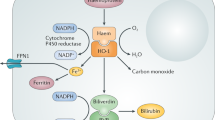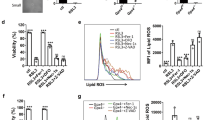Abstract
Reactive oxygen species are involved in many cellular metabolic and signalling processes1 and are thought to have a role in disease, particularly in carcinogenesis and ageing2. We have generated mice with targeted inactivation of Prdx1, a member of the peroxiredoxin family of antioxidant enzymes3. Here we show that mice lacking Prdx1 are viable and fertile but have a shortened lifespan owing to the development beginning at about 9 months of severe haemolytic anaemia and several malignant cancers, both of which are also observed at increased frequency in heterozygotes. The haemolytic anaemia is characterized by an increase in erythrocyte reactive oxygen species, leading to protein oxidation, haemoglobin instability, Heinz body formation and decreased erythrocyte lifespan. The malignancies include lymphomas, sarcomas and carcinomas, and are frequently associated with loss of Prdx1 expression in heterozygotes, which suggests that this protein functions as a tumour suppressor. Prdx1-deficient fibroblasts show decreased proliferation and increased sensitivity to oxidative DNA damage, whereas Prdx1-null mice have abnormalities in numbers, phenotype and function of natural killer cells. Our results implicate Prdx1 as an important defence against oxidants in ageing mice.
This is a preview of subscription content, access via your institution
Access options
Subscribe to this journal
Receive 51 print issues and online access
$199.00 per year
only $3.90 per issue
Buy this article
- Purchase on Springer Link
- Instant access to full article PDF
Prices may be subject to local taxes which are calculated during checkout



Similar content being viewed by others
References
Finkel, T. Oxygen radicals and signaling. Curr. Opin. Cell Biol. 10, 248–253 (1998)
Finkel, T. & Holbrook, N. J. Oxidants, oxidative stress and the biology of ageing. Nature 408, 239–246 (2000)
Chae, H. Z. et al. Cloning and sequencing of thiol-specific antioxidant from mammalian brain: alkyl hydroperoxide reductase and thiol-specific antioxidant define a large family of antioxidant enzymes. Proc. Natl Acad. Sci. 91, 7017–7021 (1994)
Prosperi, M. T., Ferbus, D., Karczinski, I. & Goubin, G. A human cDNA corresponding to a gene overexpressed during cell proliferation encodes a product sharing homology with amoebic and bacterial proteins. J. Biol. Chem. 268, 11050–11056 (1993)
Ishii, T. et al. Cloning and characterization of a 23-kDa stress-induced mouse peritoneal macrophage protein. J. Biol. Chem. 268, 18633–18636 (1993)
Prosperi, M. T., Apiou, F., Dutrillaux, B. & Goubin, G. Organization and chromosomal assignment of two human PAG gene loci: PAGA encoding a functional gene and PAGB a processed pseudogene. Genomics 19, 236–241 (1994)
Lyu, M. S. et al. Genetic mapping of six mouse peroxiredoxin genes and fourteen peroxiredoxin related sequences. Mammal. Genome 10, 1017–1019 (1999)
Prosperi, M.-T., Ferbus, D., Rouillard, D. & Goubin, G. The pag gene product, a physiological inhibitor of c-abl tyrosine kinase, is overexpressed in cells entering S phase and by contact with agents inducing oxidative stress. FEBS Lett. 423, 39–44 (1998)
Kang, S. W. et al. Mammalian peroxiredoxin isoforms can reduce hydrogen peroxide in response to growth factors and tumor necrosis factor-α. J. Biol. Chem. 273, 6297–6302 (1998)
Shau, H., Gupta, R. K. & Golub, S. H. Identification of a natural killer enhancing factor (NKEF) from human erythroid cells. Cell. Immunol. 147, 1–11 (1993)
Iwahara, S. et al. Purification, characterization, and cloning of a heme-binding protein (23 kDa) in rat liver cytosol. Biochemistry 34, 13398–13406 (1995)
Wen, S.-T. & Van Etten, R. A. The PAG gene product, a stress-induced protein with antioxidant properties, is an Abl SH3-binding protein and a physiological inhibitor of c-Abl tyrosine kinase activity. Genes Dev. 11, 2456–2467 (1997)
Chang, T.-S. et al. Regulation of peroxiredoxin I activity by Cdc2-mediated phosphorylation. J. Biol. Chem. 277, 25370–25376 (2002)
Shau, H. et al. Endogenous natural killer enhancing factor-B increases cellular resistance to oxidative stress. Free Radic. Biol. Med. 22, 497–507 (1997)
Chung, Y. M., Yoo, Y. D., Park, J. K., Kiim, Y.-T. & Kim, H. J. Increased expression of peroxiredoxin II confers resistance to cisplatin. Anticancer Res. 21, 1129–1134 (2001)
Struthers, L., Patel, R., Clark, J. & Thomas, S. Direct detection of 8-oxodeoxyguanosine and 8-oxoguanine by avidin and its analogues. Anal. Biochem. 255, 20–31 (1998)
Cerewenka, A. & Lanier, L. L. Natural killer cells, viruses and cancer. Nature Rev. Immunol. 1, 41–49 (2001)
Takei, F., Brennan, J. & Mager, D. L. The Ly49 family: genes, proteins and recognition of class I MHC. Immunol. Rev. 155, 67–77 (1997)
Sauri, H., Ashjian, P. H., Kim, A. T. & Shau, H. Recombinant natural killer enhancing factor augments natural killer cytotoxicity. J. Leuk. Biol. 59, 925–931 (1996)
Butterfield, L. H., Merino, A., Golub, S. H. & Shau, H. From cytoprotection to tumor suppression: the multifactorial role of peroxiredoxins. Antioxid. Redox Signal. 1, 385–402 (1999)
Johnson, R. M., Goyette, G., Ravindranath, Y. & Ho, Y.-S. Red cells from glutathione peroxidase-1-deficient mice have nearly normal defenses against exogenous peroxides. Blood 96, 1985–1988 (2000)
Friedman, J. S. et al. Absence of mitochondrial superoxide dismutase results in a murine hemolytic anemia responsive to therapy with a catalytic antioxidant. J. Exp. Med. 193, 925–934 (2001)
Henderson, C. J. et al. Increased skin tumorigenesis in mice lacking pi class glutathione S-transferases. Proc. Natl Acad. Sci. USA 95, 5275–5280 (1998)
Ramos-Gomez, M. et al. Sensitivity to carcinogenesis in increased and chemoprotective efficacy of enzyme inducers is lost in Nrf2 transcription factor-deficient mice. Proc. Natl Acad. Sci. USA 98, 2941–2943 (2001)
Noh, D.-Y. et al. Overexpression of peroxiredoxin in human breast cancer. Anticancer Res. 21, 2085–2090 (2001)
Mu, Z. M., Yin, X. Y. & Prochownik, E. V. Pag, a putative tumor suppressor, interacts with the Myc box II domain of c-Myc and selectively alters its biological function and target gene expression. J. Biol. Chem. 277, 43175–43184 (2002)
Westphal, C. H. & Leder, P. Transposon-generated ‘knock-out’ and ‘knock-in’ gene-targeting constructs for use in mice. Curr. Biol. 7, 530–533 (1997)
Hoffmann-Fezer, G. et al. Biotin labeling as an alternative nonradioactive approach to determination of red cell survival. Ann. Hematol. 67, 81–87 (1993)
Frank, J., Biesalski, H. K., Dominici, S. & Pompella, A. The visualization of oxidant stress in tissues and isolated cells. Histol. Histopathol. 15, 173–184 (2000)
Dubey, D. P. et al. The MHC influences NK and NKT cell functions associated with immune abnormalities and life span. Mech. Aging Dev. 113, 117–134 (2000)
Lee, T.-H. et al. Peroxiredoxin II is essential for sustaining life span of erythrocytes in mice. Blood 101, 5033–5038 (2003)
Acknowledgements
We thank C. Westphal, P. Leder, K. Smith, J. Alverez, J. Pinkas and C. Brugnara for assistance, and H. F. Bunn for discussions. This work was supported by NIH grants to C.A.N., S.D., D.P.D. and R.A.V.
Author information
Authors and Affiliations
Corresponding author
Ethics declarations
Competing interests
The authors declare that they have no competing financial interests.
Rights and permissions
About this article
Cite this article
Neumann, C., Krause, D., Carman, C. et al. Essential role for the peroxiredoxin Prdx1 in erythrocyte antioxidant defence and tumour suppression. Nature 424, 561–565 (2003). https://doi.org/10.1038/nature01819
Received:
Accepted:
Issue Date:
DOI: https://doi.org/10.1038/nature01819
This article is cited by
-
Analysis and identification of oxidative stress-ferroptosis related biomarkers in ischemic stroke
Scientific Reports (2024)
-
LncFASA promotes cancer ferroptosis via modulating PRDX1 phase separation
Science China Life Sciences (2024)
-
Celastrol suppresses colorectal cancer via covalent targeting peroxiredoxin 1
Signal Transduction and Targeted Therapy (2023)
-
Peroxiredoxins in erythrocytes: far beyond the antioxidant role
Journal of Molecular Medicine (2023)
-
Animal models of male subfertility targeted on LanCL1-regulated spermatogenic redox homeostasis
Lab Animal (2022)
Comments
By submitting a comment you agree to abide by our Terms and Community Guidelines. If you find something abusive or that does not comply with our terms or guidelines please flag it as inappropriate.



